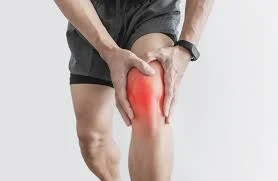Knee pain is a common issue affecting people of all ages and lifestyles. It’s pain or discomfort experienced in or around your knee joint, which is the largest joint in your body. This joint connects your thigh bone (femur) with your shin bone (tibia) and plays a crucial role in supporting your weight and facilitating movement. Understanding the causes, treatment options, and prevention strategies for knee pain can help you manage and alleviate this condition effectively.
What is Knee Pain?
Knee pain refers to any discomfort or ache in or around your knee joint. The knee is a complex joint where the femur meets the tibia, making it susceptible to various types of injuries and conditions. As the largest joint in your body, the knee bears much of your weight during activities like walking, running, and jumping. This significant load can sometimes lead to pain, whether it’s a temporary issue or a chronic condition requiring medical attention.
The location of your knee pain can provide clues about its cause. Pain close to the surface, above or behind your knee, is often related to muscles, tendons, or ligaments. Deeper pain within the knee may involve bones or cartilage. Occasionally, knee pain can radiate to surrounding areas like your lower leg or thigh, depending on the underlying issue.
Common Causes of Knee Pain
Overuse
Overuse is a frequent cause of knee pain, especially for those who engage in repetitive physical activities. Activities such as running, jumping, or kneeling can stress the knee joint, leading to conditions like:
- Patellofemoral Pain Syndrome (PFPS): Often referred to as runner’s knee, this condition is characterised by pain around the kneecap.
- Osgood-Schlatter Disease: This affects adolescents and causes pain just below the kneecap due to repetitive stress.
- Tendinitis: Particularly patellar tendinitis, which affects the tendon connecting the kneecap to the shinbone.
- Bursitis: Inflammation of the bursa, a small fluid-filled sac that reduces friction between tissues.
Arthritis
Arthritis is another common cause of knee pain, causing inflammation and pain in the joint. Types of arthritis that can affect the knee include:
- Osteoarthritis: The most common form, resulting from wear and tear on the joint.
- Rheumatoid Arthritis: An autoimmune condition that causes chronic inflammation.
- Post-Traumatic Arthritis: Develops after a knee injury, leading to joint pain and stiffness.
Injuries
Injuries are a frequent cause of knee pain and can range from minor strains to severe trauma. Common knee injuries include:
- Knee Sprains: Damage to the ligaments supporting the knee.
- Hyperextended Knees: Over-stretching of the knee joint.
- Ligament Tears: Injuries to the ACL, PCL, MCL, or LCL ligaments.
- Meniscus Tears: Damage to the cartilage that cushions the knee joint.
- Bone Fractures: Breaks or cracks in the bones around the knee.
- Dislocations: When the knee cap moves out of its normal position.
Treatment and Care for Knee Pain
Home Remedies
Many cases of knee pain can be managed at home using the RICE method:
- Rest: Avoid activities that exacerbate the pain.
- Ice: Apply an ice pack to reduce swelling, ideally for 15 to 20 minutes every hour during the first 24 hours.
- Compression: Use a bandage or wrap to reduce swelling and support the knee.
- Elevation: Keep your knee elevated above heart level to minimise swelling.
Medications
Over-the-counter medications can help alleviate knee pain and inflammation. Non-steroidal anti-inflammatory drugs (NSAIDs) like ibuprofen and naproxen can be effective, but they should not be used for more than 10 days without medical advice. Acetaminophen (Tylenol®) is another option for pain relief.
Knee Braces
Knee braces provide support and help align the knee properly. They are typically made from plastic or metal and can help stabilise the joint, reducing pain and aiding in recovery.
Physical Therapy
For persistent knee pain or recovery from injury, physical therapy may be recommended. A physical therapist can guide you through exercises and stretches to strengthen the muscles around your knee, improving stability and reducing pain.
Surgery
Surgery is generally considered a last resort if other treatments fail. Options include:
- Knee Arthroscopy: A minimally invasive procedure where a camera is used to view and repair damage inside the knee.
- Knee Replacement (Arthroplasty): Involves replacing the damaged knee joint with an artificial one, suitable for severe arthritis or extensive damage.
Preventing Knee Pain
While you may not always prevent knee pain, especially from unavoidable injuries, there are measures you can take to reduce the risk:
- Wear Protective Gear: Use appropriate equipment during sports and physical activities.
- Avoid Ignoring Pain: Don’t continue to exercise through knee pain; allow time for recovery.
- Warm Up and Cool Down: Stretching before and after physical activity helps prepare your muscles and prevent injury.
- Maintain a Safe Environment: Keep your home free of obstacles to prevent tripping and use proper tools to avoid unnecessary strain on your knees.
When to Seek Medical Advice
Consult a healthcare provider if knee pain persists or significantly impacts your daily activities. Immediate medical attention is necessary if you experience severe trauma, an inability to move your knee or leg, or suspect a broken bone.
Knee pain is a widespread issue that can disrupt daily life, but with proper understanding and treatment, relief is possible. Always listen to your body and seek medical advice if pain persists or worsens. Taking proactive steps towards management and prevention can help you stay active and pain-free.






Social Media Icons